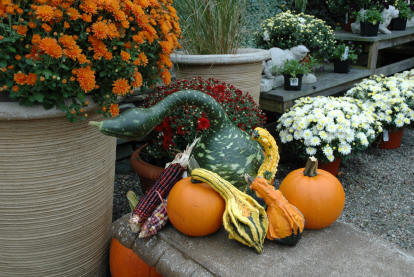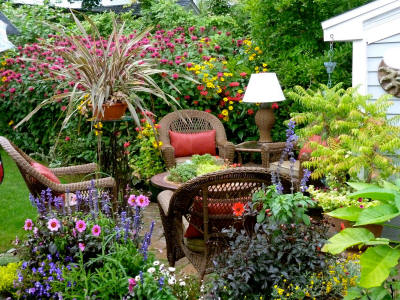Mary Ann Ryan
Adams County Master Gardener

(6/2016) Although our property isn’t small, we have a few "small spaces". These spaces have been created through sitting areas, clumps of trees, and utilitarian buildings.
When we first built our house 19 years ago, we planted many tree seedlings with the hope of creating some of these special spaces. One such space is our birch tree grove. We planted what now appears to be five clump birch trees, but in fact it was three seedlings we planted in each of the five holes, creating that natural clump affect. Part of the
grove is under-planted with Ilex verticillata - winterberry hollies. Now that the trees are mature and the garden shaded, I have added Christmas ferns, Heuchera (coral bells), and Packera aurea (ragwort) and Thermopsis caroliniana (false lupine) to the bed, creating a very natural, intimate space, all shades of yellow and green. This space is probably about 20’x10’, so
there’s not a lot of any one plant, but a nice variety with interesting textures and colors.
 This space can further be developed by adding a small seating area and a few containers for additional color. Suddenly within a large space, a small garden that can be viewed and experienced in a very personal way has been created.
This space can further be developed by adding a small seating area and a few containers for additional color. Suddenly within a large space, a small garden that can be viewed and experienced in a very personal way has been created.
Another fun small area is by our patio. The two trees that shade it are paperbark maple and pagoda dogwood. Both are small trees, about 20’ tall. The Acer griseum, paperbark maple, has interesting peeling bark. I have pruned it so the bark is visible while sitting on the patio. This tree also gets a wonderful orange-red fall color. The Cornus
alternifolia, pagoda dogwood, has low branches that just about hit the ground with white flowers in May. These trees have created a small understory area that I have a collection of shade perennials like hosta, ferns and hellebores. Each of these perennial plants has unique textures and foliage colors that can be seen and enjoyed close up – the beauty of a small garden.
Small spaces do not mean that gardening cannot be done. As a matter of fact, I enjoy small spaces better than large areas. Plants are seen individually and enjoyed up close, as opposed to mass planting and quick viewing. Small areas allow us to really work with different textures, shape and colors. Maintaining them is even more enjoyable. Weeding
is easy and can be accomplished in a quick manner.
There are some limitations, however. We can’t plant everything. Site analysis, like understanding the sun, wind and soil will define the plant community. Not always in a small space can vegetables be planted. If there are trees shading the garden, you will be limited to ornamentals and not edibles, although a shade garden will allow for a great
place to have a few chairs for relaxing.
Sun allows for edibles and ornamentals, but if a sitting area is needed provisions by umbrellas or some type of trellising will have to be considered. Deciduous flowering shrubs can be easily used in a sun garden, remembering that many flowering shrubs can get some great size to them. Using them individually as focal points or pruned into more of a
tree form can make a great impact on a small garden.
Vegetables can be introduced in a sun garden within the planting beds mixed in with the ornamentals, allowing you to really work with textures and colors. Having great fruit color and interesting leaf texture makes some vegetable plants a great addition to a perennial bed. For instance the fern like leaves of the asparagus is a great background
plant. The course texture of zucchini leaves make a great accent plant, and the climbing ability of a cherry tomato is great for on a trellis, as the red tomatoes are quite pretty.
 Imagine sitting at a small bistro table with your best friend under an umbrella with a climbing cherry tomato plant behind you and plucking those tomatoes as a snack while relaxing. And in the corner of your small garden is a Physocarpus opulifolius ‘Diablo’, an dark leafed
ninebark, growing as a focal point, reaching 8’ high with peeling bark and allowed to arch over a ground cover of strawberries that you picked and made some jelly. And how about a small birdbath in the other corner that has a few Deutizia gracilis ‘Nikko’, a dwarf deutzia that gets white flowers in the spring, at the base? Mix in a few sun perennials like Phlox paniculata
(garden phlox) and Rudbeckia hirta (black eyed susan) and your small garden is filled with blooming plants to be enjoyed throughout the seasons.
Imagine sitting at a small bistro table with your best friend under an umbrella with a climbing cherry tomato plant behind you and plucking those tomatoes as a snack while relaxing. And in the corner of your small garden is a Physocarpus opulifolius ‘Diablo’, an dark leafed
ninebark, growing as a focal point, reaching 8’ high with peeling bark and allowed to arch over a ground cover of strawberries that you picked and made some jelly. And how about a small birdbath in the other corner that has a few Deutizia gracilis ‘Nikko’, a dwarf deutzia that gets white flowers in the spring, at the base? Mix in a few sun perennials like Phlox paniculata
(garden phlox) and Rudbeckia hirta (black eyed susan) and your small garden is filled with blooming plants to be enjoyed throughout the seasons.
Small spaces are synonymous with the use of containers. Container gardening allows a person to grow multiple types of plants in areas that have hard surfaces, like patios, decks and walkways. Typically we think of container gardening as growing annuals. So plants like geraniums, petunias, and million bells are often what we might envision. However,
container gardening can be so much more. Vegetables, perennials and even small shrubs can be grown.
When choosing the container, consider what type of plants you will be growing in them, how big the plants are going to get and how much sun they will need. The sunnier the location, the more likely a pot that is plastic, or something other than clay, should be used. Clay, although looks great, dries out very quickly and watering daily is
imperative. However, in the shade, a clay pot will do just fine.
The type of plants grown in containers will determine the size of the pot. For instance, vegetables require large pots – 16" or larger, depending on the plant. Tomatoes, squash, and cucumbers would need a minimum of a 16" pot, but if lettuce is your vegetable of choice, a smaller pot will do. Annuals plants are great in containers for quick color,
and a variety of container sizes can be used.
Potting mix is important when growing in containers. There are many on the market. Whenever we talk about growing plants, we always start with the soil, and container gardening is no different in that aspect. However, the soil we use is soilless mixes. These are the mixes we purchase, not dig up from our yards. Soilless mixes are used because they
do not compact and harden in containers like native soil does, and they are sterile, so do not carry and soil-borne diseases that can pass onto the plants. Many potting mixes are peat based, however, some mixes contain peanut shells, composted bark, or even coir. Coir is natural fiber made from the husk of coconuts.
Don’t limit yourself to turf and annuals in a small space – think about flowering shrubs, small trees, perennials and vegetables. If you have a small space, go crazy and design a great garden. Enjoy the space and all that can be done within that garden.
Read other articles on garden and landscape design